
The Chinese yuan did not manage to hold on to rises it saw on Tuesday as foreign exchange trading hit the midpoint of an unusual week.
The offshore version of the yuan, which is traded on the free market against other currencies as opposed to the centrally controlled onshore version, saw some brief gains on Tuesday.
It went to its highest point in the last week on Tuesday in its pair with the US dollar. However, these gains were practically wiped out on Wednesday when it plummeted by two-fifths of a percentage point.
The reasons for this new-found decline were complex. It happened in spite of news out of the United States that the imposition of tariffs, which had been expected to hit in a few weeks at the start of September, were now going to be delayed indefinitely.
US President Donald Trump said that the fees, which would have been responsible for price rises in a range of technological items produced in China and sold in the US, would now not transpire on the expected date.
This came after representatives of both governments held fresh talks aimed at alleviating the crisis, which has now been going on for a number of months and shows no sign of abating.
Analysts believed that the main reason for the change was the release of a negative economic index. Industrial output, which is a key indicator of the performance of any economy but especially of an export-heavy one like China’s, saw a rise which was the weakest in almost 20 years.
This is likely to have been fuelled by uncertainty about demand given the ongoing issues with the US.
The Chinese central bank also announced that it would position the onshore yuan at 7.03, a decision which may appear to the outside world – and especially to the United States – as a concessionary move, perhaps delivered in response to the olive branch thrown by the US administration over tariff imposition.
Elsewhere, the so-called safe haven Japanese yen also see-sawed, but this time in the opposite direction to its near neighbour China. It rose by 0.4% against the US dollar as Wednesday began, and reached 106.33 at one stage. However, this came after it dropped to its lowest point in a week just before that.
Over in Europe, currencies tended to remain on a largely firm footing as trading got properly underway.
The pound sterling reached $1.2056 against the US dollar, perhaps as a result of what appears to be a short summer lull in the ongoing wrangling over Brexit.
The single European currency remained steady against the US dollar too. It was recorded at $1.1180.
The eurozone is facing a number of problems at the moment, including in Germany and Italy – two of its major economies.
It was widely believed, however, that gross domestic product data for the bloc due out this morning was not likely to show a contraction, and that it was instead remain firm.
 Between 74-89% of CFD traders lose
Between 74-89% of CFD traders lose  Your capital is at risk
Your capital is at risk  Your capital is at risk
Your capital is at risk  Your capital is at risk
Your capital is at risk